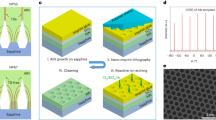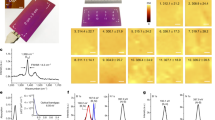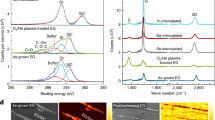Abstract
Epitaxy is a process by which a thin layer of one crystal is deposited in an ordered fashion onto a substrate crystal. The direct epitaxial growth of semiconductor heterostructures on top of crystalline superconductors has proved challenging. Here, however, we report the successful use of molecular beam epitaxy to grow and integrate niobium nitride (NbN)-based superconductors with the wide-bandgap family of semiconductors—silicon carbide, gallium nitride (GaN) and aluminium gallium nitride (AlGaN). We apply molecular beam epitaxy to grow an AlGaN/GaN quantum-well heterostructure directly on top of an ultrathin crystalline NbN superconductor. The resulting high-mobility, two-dimensional electron gas in the semiconductor exhibits quantum oscillations, and thus enables a semiconductor transistor—an electronic gain element—to be grown and fabricated directly on a crystalline superconductor. Using the epitaxial superconductor as the source load of the transistor, we observe in the transistor output characteristics a negative differential resistance—a feature often used in amplifiers and oscillators. Our demonstration of the direct epitaxial growth of high-quality semiconductor heterostructures and devices on crystalline nitride superconductors opens up the possibility of combining the macroscopic quantum effects of superconductors with the electronic, photonic and piezoelectric properties of the group III/nitride semiconductor family.
This is a preview of subscription content, access via your institution
Access options
Access Nature and 54 other Nature Portfolio journals
Get Nature+, our best-value online-access subscription
$29.99 / 30 days
cancel any time
Subscribe to this journal
Receive 51 print issues and online access
$199.00 per year
only $3.90 per issue
Buy this article
- Purchase on Springer Link
- Instant access to full article PDF
Prices may be subject to local taxes which are calculated during checkout




Similar content being viewed by others
References
Onnes, H. K. Investigations into the Properties of Substances at Low Temperatures, Which Have Led, Amongst Other Things, to the Preparation of Liquid Helium. (Nobel Lectures, 1913)
Riordan, M. & Hoddeson, L. in Crystal Fire 88–90 (WW Norton and Company, 1998)
Kroemer, H. Nobel lecture. Quasielectric fields and band offsets: teaching electrons new tricks. Rev. Mod. Phys. 73, 783–793 (2001)
Alferov, Z. I. Nobel lecture. The double heterostructure concept and its applications in physics, electronics, and technology. Rev. Mod. Phys. 73, 767–782 (2001)
Jena, D. Tunneling transistors based on graphene and 2-D crystals. Proc. IEEE 101, 1585–1602 (2013)
Ladd, T. D. et al. Quantum computers. Nature 464, 45–53 (2010)
Mooij, J. et al. Josephson persistent-current qubit. Science 285, 1036–1039 (1999)
Lancaster, M . et al. Superconducting microwave resonators. In IEE Proceedings H (Microwaves, Antennas and Propagation), vol. 139, 149–156 (IET, 1992)
Cassidy, M. C. et al. Demonstration of an ac Josephson junction laser. Science 355, 939–942 (2017)
Gol’tsman, G. N., Okunev, O., Chulkova, A., Lipatov, A., Semenov, K., Voronov, B. & Dzardanov, A. Picosecond superconducting single-photon optical detector. Appl. Phys. Lett. 79, 705–707 (2001)
Mourik, V. et al. Signatures of Majorana fermions in hybrid superconductor-semiconductor nanowire devices. Science 336, 1003–1007 (2012)
Sarma, S. D., Freedman, M. & Nayak, C. Majorana zero modes and topological quantum computation. npj Quant. Information 1, 15001 (2015)
Krogstrup, P. et al. Epitaxy of semiconductor–superconductor nanowires. Nat. Mater. 14, 400–406 (2015)
Yue, Y. et al. Ultrascaled InAlN/GaN high electron mobility transistors with cutoff frequency of 400 GHz. Jpn. J. Appl. Phys. 52, 08JN14 (2013)
Li, W. et al. Polarization-engineered III-nitride heterojunction tunnel field-effect transistors. Exploratory solid-state computational devices and circuits. IEEE J. Exp. Solid State Comp. Devices Circuits 1, 28–34 (2015)
Hu, Z. et al. Near unity ideality factor and Shockley-Read-Hall lifetime in GaN-on-GaN pn diodes with avalanche breakdown. Appl. Phys. Lett. 107, 243501 (2015)
Islam, S. M. et al. MBE-grown 232–270 nm deep-UV LEDs using monolayer thin binary GaN/AlN quantum heterostructures. Appl. Phys. Lett. 110, 041108 (2017)
Sheu, J.-K. et al. White-light emission from near UV InGaN-GaN LED chip precoated with blue/green/red phosphors. IEEE Photonics Technol. Lett. 15, 18–20 (2003)
Dubois, M.-A. & Muller, C. in MEMS-based Circuits and Systems for Wireless Communication (eds Enz, C. C. & Kaiser, A. ) 3–28 (Springer, 2013)
Pernice, W. H. et al. High-speed and high-efficiency travelling wave single-photon detectors embedded in nanophotonic circuits. Nat. Commun. 3, 1325 (2012)
Faucher, M. et al. Niobium and niobium nitride SQUIDs based on anodized nanobridges made with an atomic force microscope. Physica C 368, 211–217 (2002)
Song, S., Jin, B., Yang, H., Ketterson, J. & Schuller, I. K. Preparation of large area NbN/AlN/NbN Josephson junctions. Jpn. J. Appl. Phys. 26, 1615 (1987)
Hajenius, M. et al. Low noise NbN superconducting hot electron bolometer mixers at 1.9 and 2.5 THz. Supercond. Sci. Technol. 17, S224 (2004)
Eastman, L. F. & Mishra, U. K. The toughest transistor yet. IEEE Spectr. 39, 28 (2002)
Katzer, D. S. et al. Epitaxial metallic β-Nb2N films grown by MBE on hexagonal SiC substrates. Appl. Phys. Exp. 8, 085501 (2015)
Meyer, D. J. et al. Epitaxial lift-off and transfer of III-N materials and devices from SiC substrates. IEEE Trans. Semicond. Manuf. 29, 384–389 (2016)
Sanjinés, R., Benkahoul, M., Sandu, C., Schmid, P. & Lévy, F. Electronic states and physical properties of hexagonal β-Nb2N and δ′-NbN nitrides. Thin Solid Films 494, 190–195 (2006)
Meyer, D. J. et al. N-polar n+ GaN cap development for low ohmic contact resistance to inverted HEMTs. Phys. Status Solidi C 9, 894–897 (2012)
Klitzing, K. v., Dorda, G. & Pepper, M. New method for high-accuracy determination of the fine-structure constant based on quantized Hall resistance. Phys. Rev. Lett. 45, 494 (1980)
Xi, X. et al. Ising pairing in superconducting NbSe2 atomic layers. Nat. Phys. 12, 139–143 (2016)
Clogston, A. M. Upper limit for the critical field in hard superconductors. Phys. Rev. Lett. 9, 266 (1962)
Nam, H. et al. Ultrathin two-dimensional superconductivity with strong spin–orbit coupling. Proc. Natl Acad. Sci. USA 113, 10513–10517 (2016)
Kozuka, Y. et al. Two-dimensional normal-state quantum oscillations in a superconducting heterostructure. Nature 462, 487–490 (2009)
Tinkham, M. Effect of fluxoid quantization on transitions of superconducting films. Phys. Rev. 129, 2413 (1963)
Aoi, K., Meservey, R. & Tedrow, P. Hc (θ) and Tinkham’s formula for high-field superconductors. Phys. Rev. B 7, 554 (1973)
Ambacher, O. et al. Two-dimensional electron gases induced by spontaneous and piezoelectric polarization charges in N-and Ga-face AlGaN/GaN heterostructures. J. Appl. Phys. 85, 3222–3233 (1999)
Jena, D. et al. Magnetotransport properties of a polarization-doped three-dimensional electron slab. Phys. Rev. B 67, 153306 (2003)
Cao, Y., Wang, K., Orlov, A., Xing, H. & Jena, D. Very low sheet resistance and Shubnikov-de Haas oscillations in two-dimensional electron gases at ultrathin binary AlN/GaN heterojunctions. Appl. Phys. Lett. 92, 152112 (2008)
Hamaguchi, C. Basic Semiconductor Physics (Springer, 2001)
Manfra, M. J. et al. Electron mobility exceeding 160 000 cm2/V s in AlGaN/GaN heterostructures grown by molecular-beam epitaxy. Appl. Phys. Lett. 85, 5394–5396 (2004)
Dingle, R. Some magnetic properties of metals. II. The influence of collisions on the magnetic behaviour of large systems. Proc. R. Soc. Lond. A 211, 517–525 (1952)
Jena, D. & Mishra, U. K. Quantum and classical scattering times due to charged dislocations in an impure electron gas. Phys. Rev. B 66, 241307 (2002)
Hsu, J. et al. Effect of growth stoichiometry on the electrical activity of screw dislocations in GaN films grown by molecular-beam epitaxy. Appl. Phys. Lett. 78, 3980–3982 (2001)
Kaun, S. W., Wong, M. H., Mishra, U. K. & Speck, J. S. Correlation between threading dislocation density and sheet resistance of AlGaN/AlN/GaN heterostructures grown by plasma-assisted molecular beam epitaxy. Appl. Phys. Lett. 100, 262102 (2012)
Shukla, N. et al. A steep-slope transistor based on abrupt electronic phase transition. Nat. Commun. 6, 7812 (2015)
Thouless, D. J., Kohmoto, M., Nightingale, M. P. & den Nijs, M. Quantized Hall conductance in a two-dimensional periodic potential. Phys. Rev. Lett. 49, 405 (1982)
Hasan, M. Z. & Kane, C. L. Colloquium. Topological insulators. Rev. Mod. Phys. 82, 3045–3067 (2010)
Beenakker, C. Search for Majorana Fermions in superconductors. Annu. Rev. Condens. Matter Phys. 4, 113–136 (2013)
Wood, C. & Jena, D. Polarization Effects in Semiconductors: From Ab-Initio Theory to Device Applications (Springer, 2007)
Miao, M. S. et al. Polarization-driven topological insulator transition in a GaN/InN/GaN quantum well. Phys. Rev. Lett. 109, 186803 (2012)
Nepal, N. et al. Characterization of molecular beam epitaxy grown β-Nb2N films and AlN/β-Nb2N heterojunctions on 6H-SiC substrates. Appl. Phys. Exp. 9, 021003 (2016)
Werthamer, N., Helfand, E. & Hohenberg, P. Temperature and purity dependence of the superconducting critical field Hc2. III. Electron spin and spin-orbit effects. Phys. Rev. 147, 295 (1966)
MacDonald, A. Transition-metal g factor trends. J. Phys. F 12, 2579 (1982)
Acknowledgements
We thank A.H. MacDonald for fruitful discussions, and D. Storm for facilitating SIMS measurements. For the measurements performed here, we made use of the Cornell Center for Materials Research (CCMR) Shared Facilities, which are supported through the National Science Foundation (NSF) Materials Research Science and Engineering Centers (MRSEC) program (grant DMR-1719875). The structure fabrications were realized in part at the Cornell NanoScale Facility, a member of the National Nanotechnology Coordinated Infrastructure (NNCI), which is supported by the NSF (grant ECCS-1542081), and a CCMR Superconductor Seed. D.J. and D.J.M. acknowledge funding support from the Office of Naval Research, monitored by P. Maki. D.J.M. also acknowledges device processing support from N. Green.
Author information
Authors and Affiliations
Contributions
R.Y., S.V. and J.W. performed electrical, magnetic and magnetotransport measurements. D.S.K, N.N, B.P.D and D.J.M grew and characterized the epitaxial layers. Y.H. performed scanning transmission electron microscopy (STEM) analysis on thin NbNx films under the supervision of D.A.M. S.R. conducted the transmission electron microscopy (TEM) measurements. R.Y. and G.K. conducted experimental data analysis and theoretical calculations, with help from D.J. and H.G.X. R.Y., G.K. and D.J. wrote the manuscript, with input from all authors.
Corresponding authors
Ethics declarations
Competing interests
The authors declare no competing financial interests.
Additional information
Reviewer Information Nature thanks Y. Krockenberger and the other anonymous reviewer(s) for their contribution to the peer review of this work.
Publisher's note: Springer Nature remains neutral with regard to jurisdictional claims in published maps and institutional affiliations.
Extended data figures and tables
Extended Data Figure 1 STEM of a large-area, MBE-grown AlN/NbNx/SiC heterostructure.
a, STEM image of NbNx/AlN grown on top of a SiC substrate, showing the single-crystal nature of NbNx over a large region. The red lines have been added as a guide to show the crystallinity across the entire range measured. b, A twin boundary and a stacking fault in the MBE NbNx layer. This STEM image of NbNx/AlN on top of SiC shows a grain boundary with two cubic NbNx phases rotated across each other. The red and blue lines have been added to draw out the stacking fault seen near the twin boundary.
Extended Data Figure 2 AFM characterizations of thin films.
a, b, AFM images of epitaxial NbNx films that are 5-nm thick (a) and 35-nm thick (b), over areas of 1 × 1 μm2 and 3 × 3 μm2. RMS, root mean squared.
Extended Data Figure 3 Symmetrical 2θ/ω XRD curves of 5-nm and 35-nm NbNx on 4H-SiC.
2θ is the angle between the incident and diffracted beams, and ω is the angle between the incident beam and the sample surface. a, The 5-nm sample. b, The 35-nm sample. There is a clear separation between the SiC and cubic NbN (first- and second-order) peaks in the 35-nm sample. But this feature is absent in the 5-nm sample, owing to the weak XDR signal intensity in such an ultrathin film.
Extended Data Figure 4 Electrical characterizations of HEMT structures.
a, Drain current (Jd) versus top-gate voltage (Vgs) transfer curves at 300 K for HEMTs grown on NbNx/SiC substrate, showing a high on/off ratio at source–drain voltages (Vds) of 0.1 V (red curve) and 3 V (blue curve). b, Jd versus Vds curves for various top-gate voltages (from bottom curve to top, −3 V, −4 V, −5 V, −6 V, −6.5 V) of GaN HEMTs at 300 K.
Extended Data Figure 5 Representative transfer curves of a HEMT structure with superconducting load.
The graph plots Jd versus Vgs (without superconductor load) and Vgs′ (with superconductor load) at 5 K, showing the phase transition of NbNx that occurs when Jd is larger than 0.1 A mm−1.
Extended Data Figure 6 Electrical characterizations of superconducting NbNx films.
a, Summary of carrier density and mobility for different thicknesses of NbNx films, ranging from 4 nm to 100 nm. The red arrow shows that the red dots correspond to the left-hand y axis; the blue squares correspond to the right-hand y axis. b, c, Critical current density as a function of temperature for 5-nm and 35-nm NbNx films.
Extended Data Figure 7 Shubnikov–de Haas oscillations of 2DEG.
a, Magnetoresistance (Rxx) plotted against inverse magnetic field (1/B) before background subtraction, taken over the magnetic-field range of 10 T to 14 T. The oscillations occur at periods of 1/B—a clear indication of sharp peaks in the 2DEG density of states owing to Landau levels. The upward black arrow indicates increasing temperatures. The inset shows the 2.2 K data (light blue) with background (blue); the non-oscillating background was removed before evaluation of carrier concentration, effective mass, and scattering time. b, Landau plot of magnetoresistance relative minima plotted against inverse magnetic field. The slope of the line is ħ2πnSdH/2m*; the density and effective mass are taken from the Lifshitz–Kosevich fit to magnetoresistance oscillations.
Extended Data Figure 8 SIMS results obtained on the SiC/NbNx/AlN/GaN/AlGaN/GaN heterostructure.
The left-hand y axis shows the secondary-ion intensity (counts per second) of Al and Ga atoms. The right-hand y axis indicates the atomic percentages of N and Nb atoms, which are respectively 43.3% and 56.7%, indicating a N/Nb ratio (x) of 0.762 in linear (a) and log (b) scale of signal intensity. The x axis denotes the depth of the sample from the top surface.
Rights and permissions
About this article
Cite this article
Yan, R., Khalsa, G., Vishwanath, S. et al. GaN/NbN epitaxial semiconductor/superconductor heterostructures. Nature 555, 183–189 (2018). https://doi.org/10.1038/nature25768
Received:
Accepted:
Published:
Issue Date:
DOI: https://doi.org/10.1038/nature25768
This article is cited by
-
Controllable growth of two-dimensional quantum materials
Science China Physics, Mechanics & Astronomy (2023)
-
Electrical conductivity enhancement of epitaxially grown TiN thin films
Journal of the Korean Physical Society (2023)
-
Ultrathin GaN Crystal Realized Through Nitrogen Substitution of Layered GaS
Journal of Electronic Materials (2023)
-
Uncovering material deformations via machine learning combined with four-dimensional scanning transmission electron microscopy
npj Computational Materials (2022)
-
Analog/RF and Power Performance Analysis of an Underlap DG AlGaN/GaN Based High-K Dielectric MOS-HEMT
Silicon (2022)
Comments
By submitting a comment you agree to abide by our Terms and Community Guidelines. If you find something abusive or that does not comply with our terms or guidelines please flag it as inappropriate.



